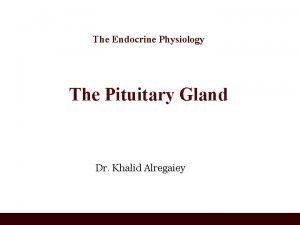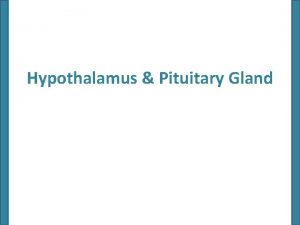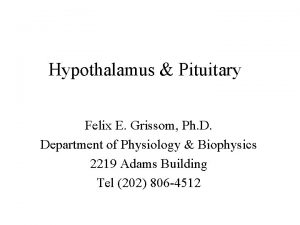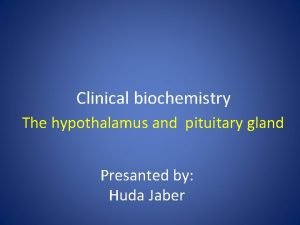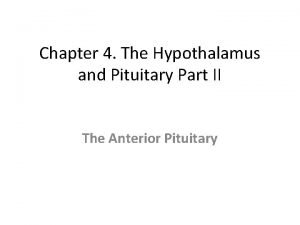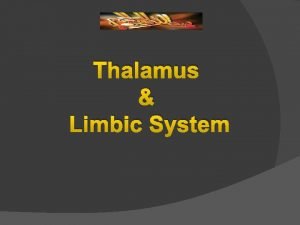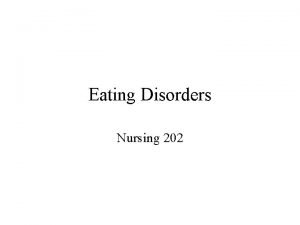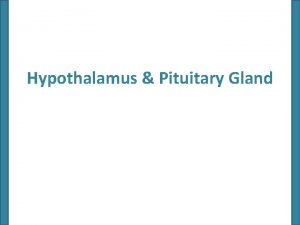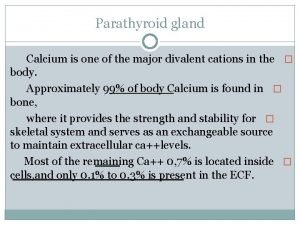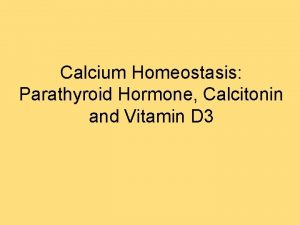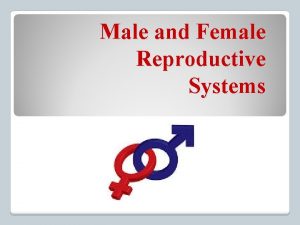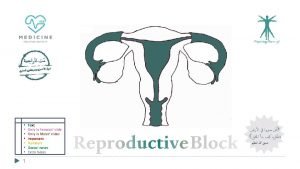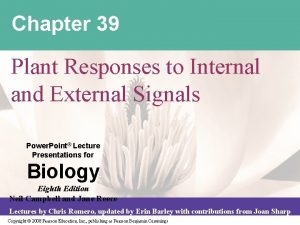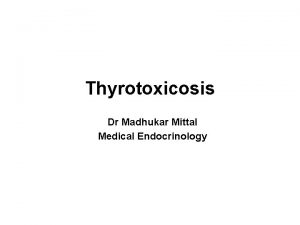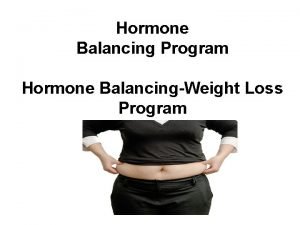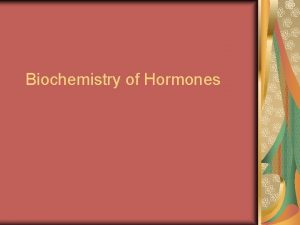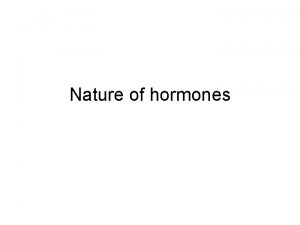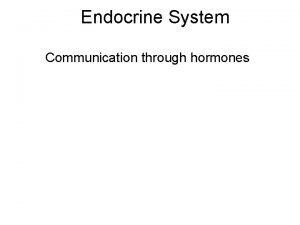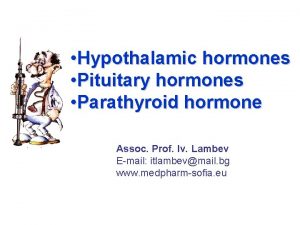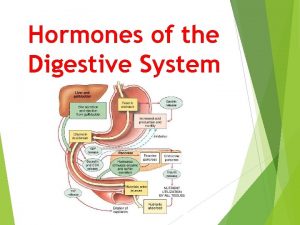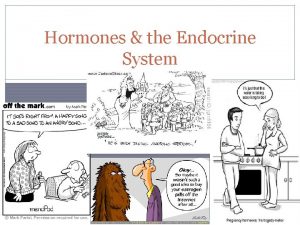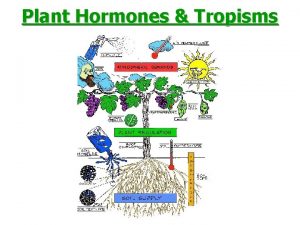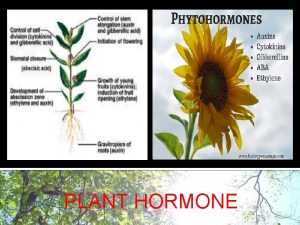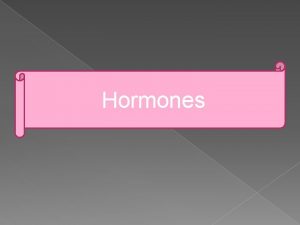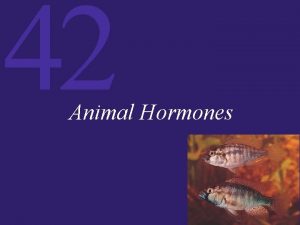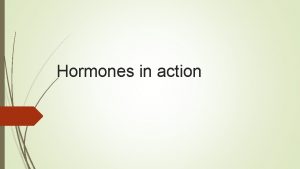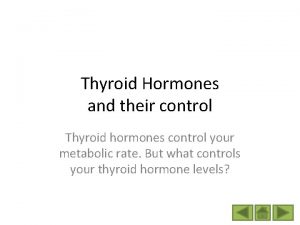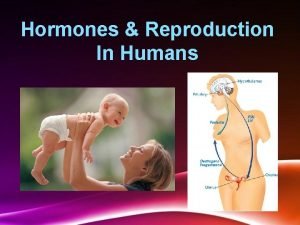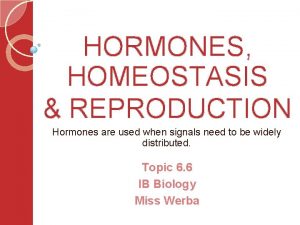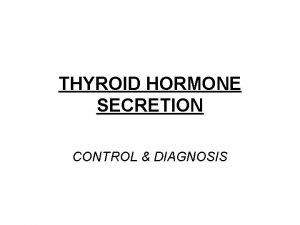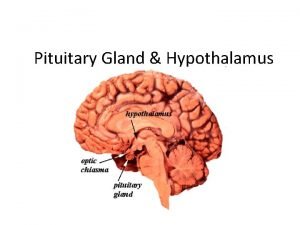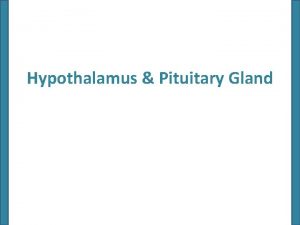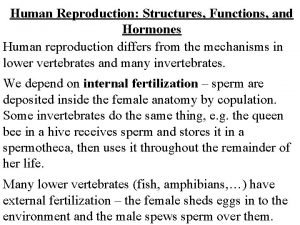Hormones and Reproduction Hormone Control n Hypothalamus Hypothalamus


























- Slides: 26

Hormones and Reproduction

Hormone Control n Hypothalamus: Hypothalamus § § Analyzes and coordinates nervous and hormonal signals produces Gonadotropin Releasing hormone (Gn. RH) which acts on the Pituitary gland. hypothalamus pituitary gland


Ø The Pituitary Gland: Receptors bind Gn. RH and releases: 1. 2. Luteinizing hormone (LH) Follicle Stimulating Hormone (FSH) Both hormones then act on: Ø the OVARIES in females Ø the TESTIS in males


ESTROGEN: Ø Ø Ø Steroid hormone At puberty results in the development of breasts, uterus and vagina; broadening of pelvis; axillary and pubic hair; increase in adipose tissue Participates in monthly preparation of body for pregnancy (Menstrual Cycle) Participates in pregnancy Secreted by the ovaries


Progesterone: Progesterone Ø Ø Ø Steroid hormone Secreted by the corpus luteum and by the placenta Prepares body for pregnancy and maintains pregnancy

The Menstrual Cycle Ø Ø ~28 days, some blood and other products from the disintegration of the inner lining of the uterus (the endometrium) are discharged from the uterus, a process called menstruation. During this time a new follicle begins to develop in one of the ovaries. After menstruation ceases, the follicle continues to develop, secreting an increasing amount of estrogen as it does so.

Ø Ø Ø The rising level of estrogen causes the endometrium to become thicker and more richly supplied with blood vessels. A rising level of LH causes the developing egg within the follicle to complete the first meiotic division, forming an oocyte. After about two weeks, there is a sudden surge in the production of LH. This surge in LH triggers ovulation: the release of the oocyte into the fallopian tube. Under the continued influence of LH, the nowempty follicle develops into a corpus luteum.

Ø Stimulated by LH, the corpus luteum secretes progesterone which: 1. continues the preparation of the endometrium for a possible pregnancy 2. inhibits the contraction of the uterus 3. inhibits the development of a new follicle

Ø If fertilization does not occur: • Ø the rising level of progesterone inhibits the release of Gn. RH which, in turn, inhibits further production of progesterone. As the progesterone levels drop: • • the corpus luteum begins to degenerate; the endometrium begins to break down the inhibition of uterine contraction is lifted, and the bleeding and cramps of menstruation begin.


PREGNANCY Ø Ø Fertilization of the egg takes place within the fallopian tube. By the end of the week, the developing embryo has become a hollow ball of cells called a blastocyst. The blastocyst reaches the uterus and embeds itself in the endometrium, a process called implantation. With implantation, pregnancy is established.


Ø 1. 2. The blastocyst is made up of two parts: the inner cell mass, which will become the baby, and the trophoblast, which develops into the extraembryonic membranes (the amniotic sac, placenta, and umbilical cord) and begins to secrete human chorionic gonadotropin (HCG).

HCG – Human Chorionic Gonadotropin Ø Ø Ø HCG is NOT inhibited by a rising level of progesterone. HCG prevents the deterioration of the corpus luteum at the end of the fourth week and enables pregnancy to continue. Because only the implanted trophoblast makes HCG, its early appearance in the urine of pregnant women provides the basis for the most widely used test for pregnancy.

Ø Ø Ø The corpeus luteum continues to make progesterone until the end of the first trimester. As pregnancy continues, the placenta becomes a major source of progesterone, and its presence is essential to maintaining the pregnancy. The placenta also becomes the “master gland”, effectively taking over the endocrine system. Miscarriages often occur at this time and are thought to be related either to the switch-over from the corpeus luteum to the placenta or from a fatal chromosomal/genetic mutation.

Birth 1. 2. 3. The placenta releases Corticotropin Releasing Hormone (CRH) which stimulates the pituitary of the fetus to secrete… Adrenocorticotropin Hormone (ACTH), which acts on the adrenal glands of the fetus causing them to release the estrogen precursor dehydroepiandrosterone sulfate (DHEA-S). This is converted into estrogen by the placenta.

4. The rising level of estrogen causes the smooth muscle cells of the uterus to 1. 2. synthesize connexins, or gap junctions. Gap junctions connect the cells electrically so that they contract together as labor begins. express receptors for oxytocin 5. Oxytocin is secreted by the posterior lobe of the pituitary as well as by the uterus. n A number of protaglandins also appear in the mother's blood as well as in the amniotic fluid. n Both oxytocin and prostaglandins cause the uterus to contract and labor begins.

Lactation • • • 2 -4 days after the baby is born, the breasts begin to secrete milk, prior to that time they are secreting colostrum. Breast milk synthesis is stimulated by the pituitary hormone prolactin and its release from the breast is stimulated by oxytocin. Breast milk contains an inhibitory peptide. If the breasts are not fully emptied, the peptide accumulates and inhibits milk production. This action thus matches supply with demand.

Hormone Interference

The Combination Pill n n n Synthetic estrogens and/or progestins are used to inhibit Gn. RH. The inhibition of Gn. RH prevents the mid-cycle surge of LH and ovulation. There is no egg to be fertilized. The progestins also attempt to prevent the sperm from reaching the egg by changing the lining of the uterus. The main side effect of the pill stem from an increased tendency for blood clots to form (estrogen enhances clotting of the blood).

RU-486 n RU-486 is a progesterone antagonist. It blocks the action of progesterone by binding more tightly to the progesterone receptor than progesterone itself. The RU-486/receptor complex is not active as a transcription factor. u Thus genes that are turned on by progesterone are turned off by RU-486. u The proteins needed to establish and maintain pregnancy are no longer synthesized. u The endometrium breaks down along with the implanted embryo. u

The embryo detaches from the uterine wall and can no longer make chorionic gonadotropin (HCG). u Consequently the corpus luteum ceases its production of progesterone. u The inhibition on uterine contraction is lifted. u Soon the embryo and the breakdown products of the endometrium are expelled. u n These properties of RU-486 have caused it to be used to induce abortion of the unwanted fetus.

EC pills n n n Emergency Contraception pills contain levonorgestrel. Levonorgestrel is the only drug that has approved for use as an emergency contraceptive. Essentially, the drug can delay or inhibit ovulation, interfere with fertilization, or prevent implantation. The drug does not work if a woman is already pregnant. If taken within 72 hours of intercourse, ECs reduce the chance of pregnancy by about 90 -95%. Pharmacists can dispense without a doctor’s prescription.
 Myxedima
Myxedima Calcitonin and pth are antagonistic hormones
Calcitonin and pth are antagonistic hormones Hypophysis
Hypophysis Hypothalamus and pituitary gland connection
Hypothalamus and pituitary gland connection Releasing inhibiting hormones
Releasing inhibiting hormones Presanted
Presanted Zeng jinlian
Zeng jinlian Hare lynx
Hare lynx Asexual reproduction cell division
Asexual reproduction cell division Asexual vs sexual reproduction venn diagram
Asexual vs sexual reproduction venn diagram Thalamus grey matter
Thalamus grey matter Hypothalamus eating disorders
Hypothalamus eating disorders Hypothalamus and pituitary gland connection
Hypothalamus and pituitary gland connection Secretory gland
Secretory gland Parathyroid gland image
Parathyroid gland image Function of calcitonin
Function of calcitonin Bioflix activity homeostasis hormones and homeostasis
Bioflix activity homeostasis hormones and homeostasis Male and female hormones
Male and female hormones Male and female hormones
Male and female hormones Bioflix activity homeostasis hormones and homeostasis
Bioflix activity homeostasis hormones and homeostasis Respond to
Respond to Plant hormones and responses
Plant hormones and responses Dr madhukar mittal
Dr madhukar mittal Parathyroid gland chief cell
Parathyroid gland chief cell Cryoablation fibroadenoma
Cryoablation fibroadenoma Nontropic hormones
Nontropic hormones Hypothalamus
Hypothalamus


